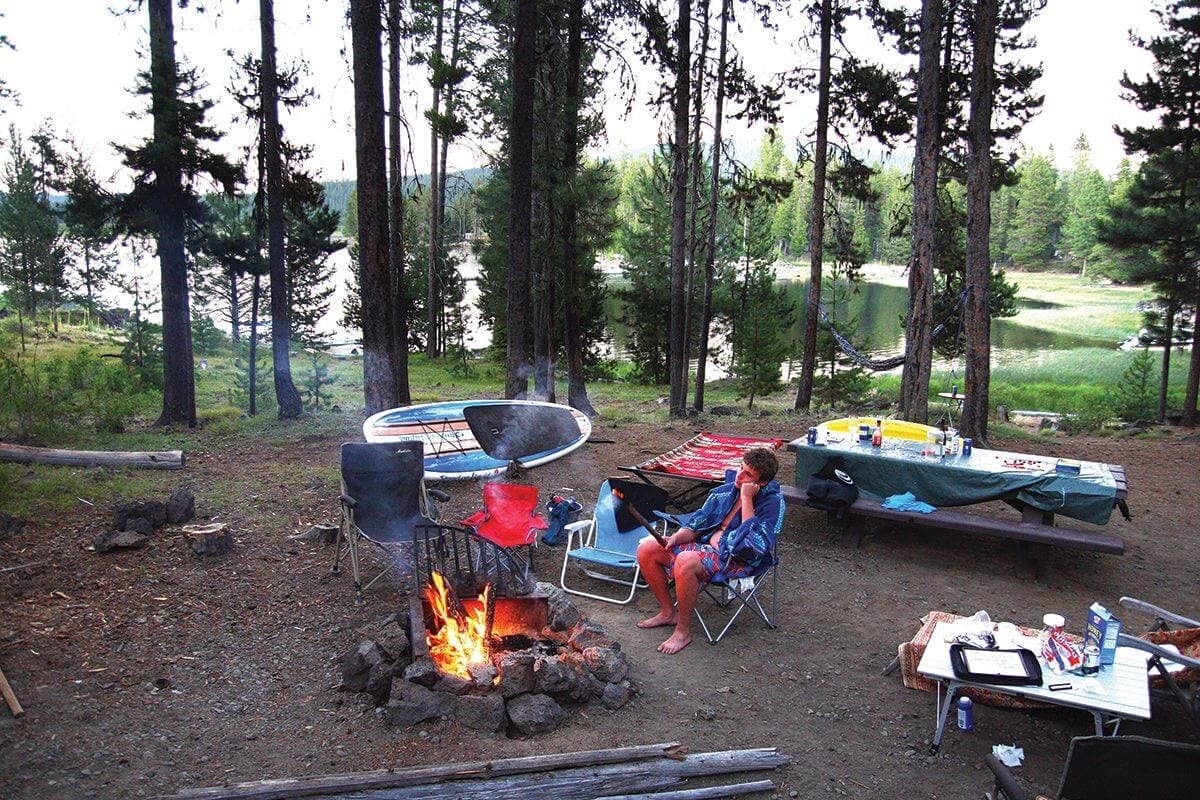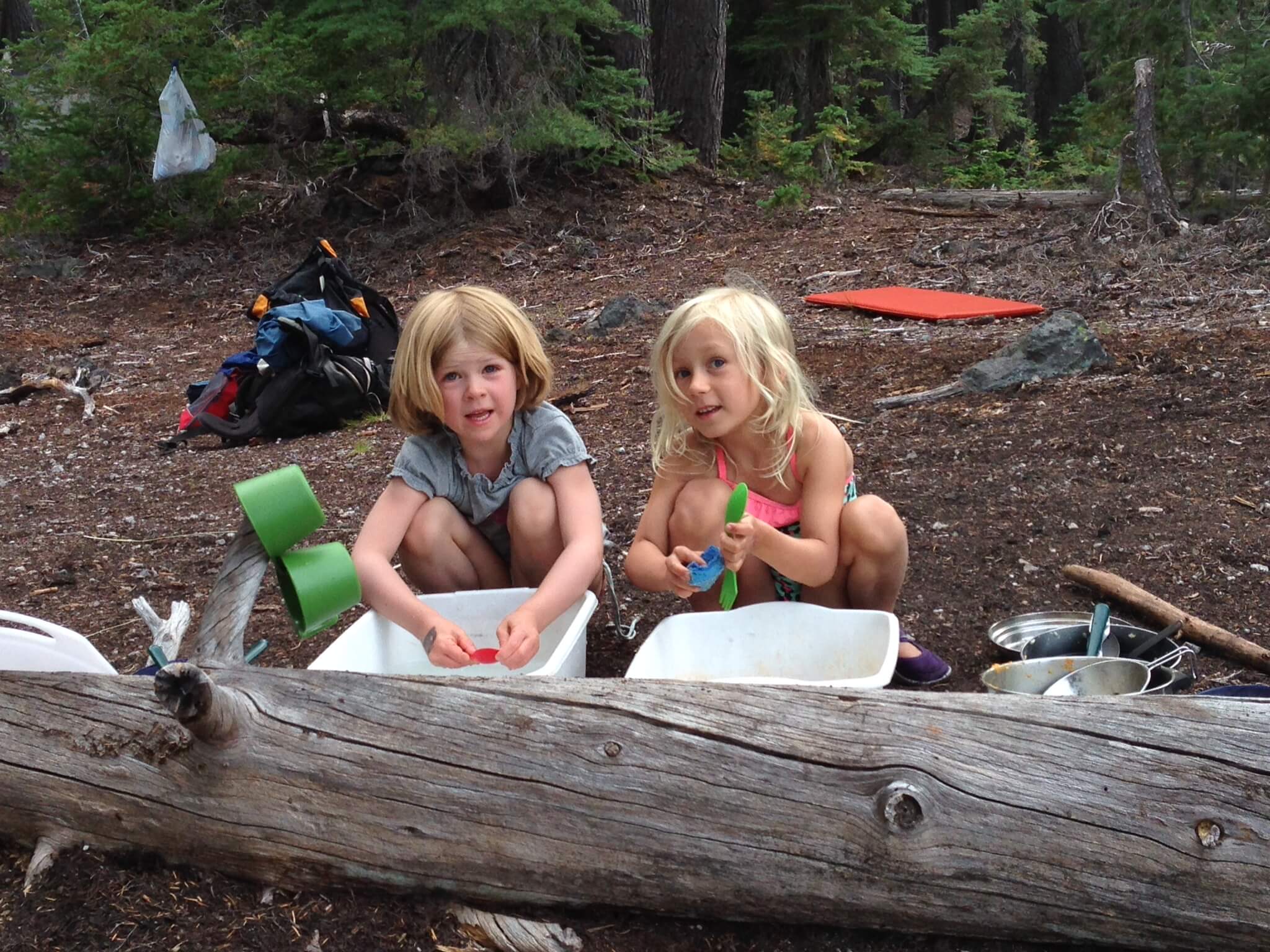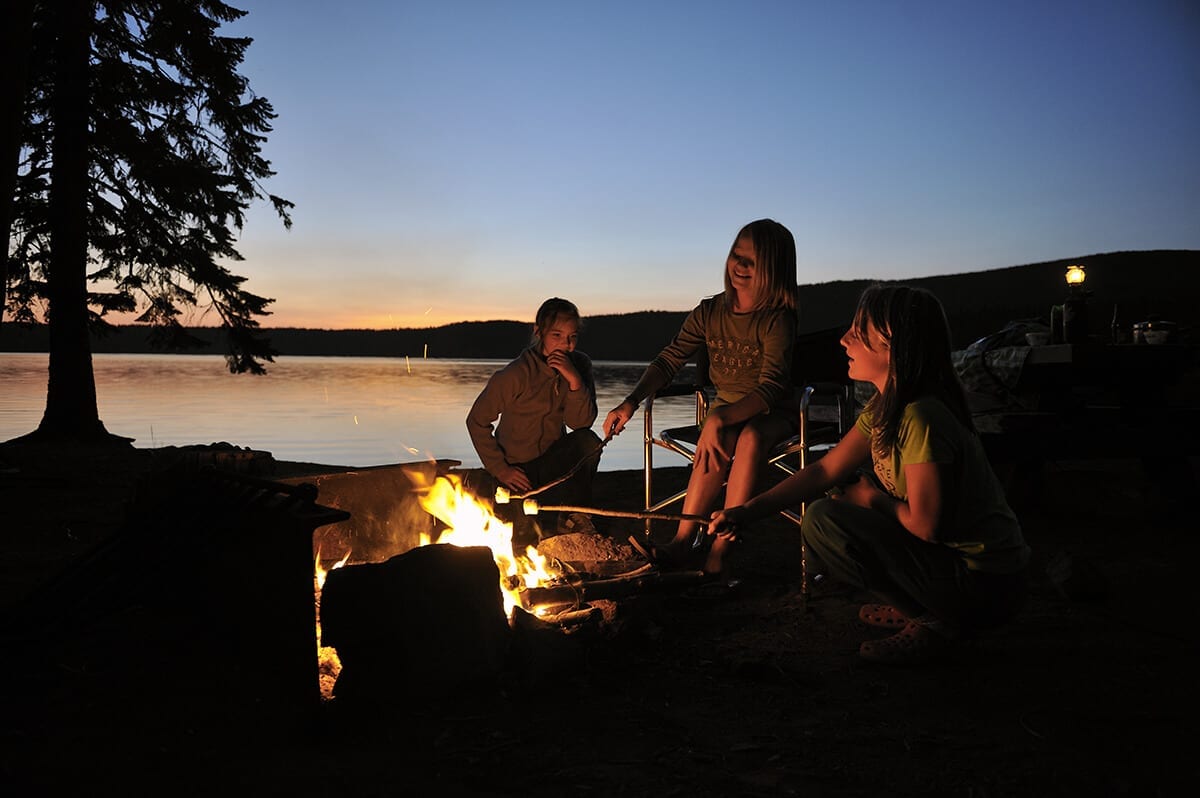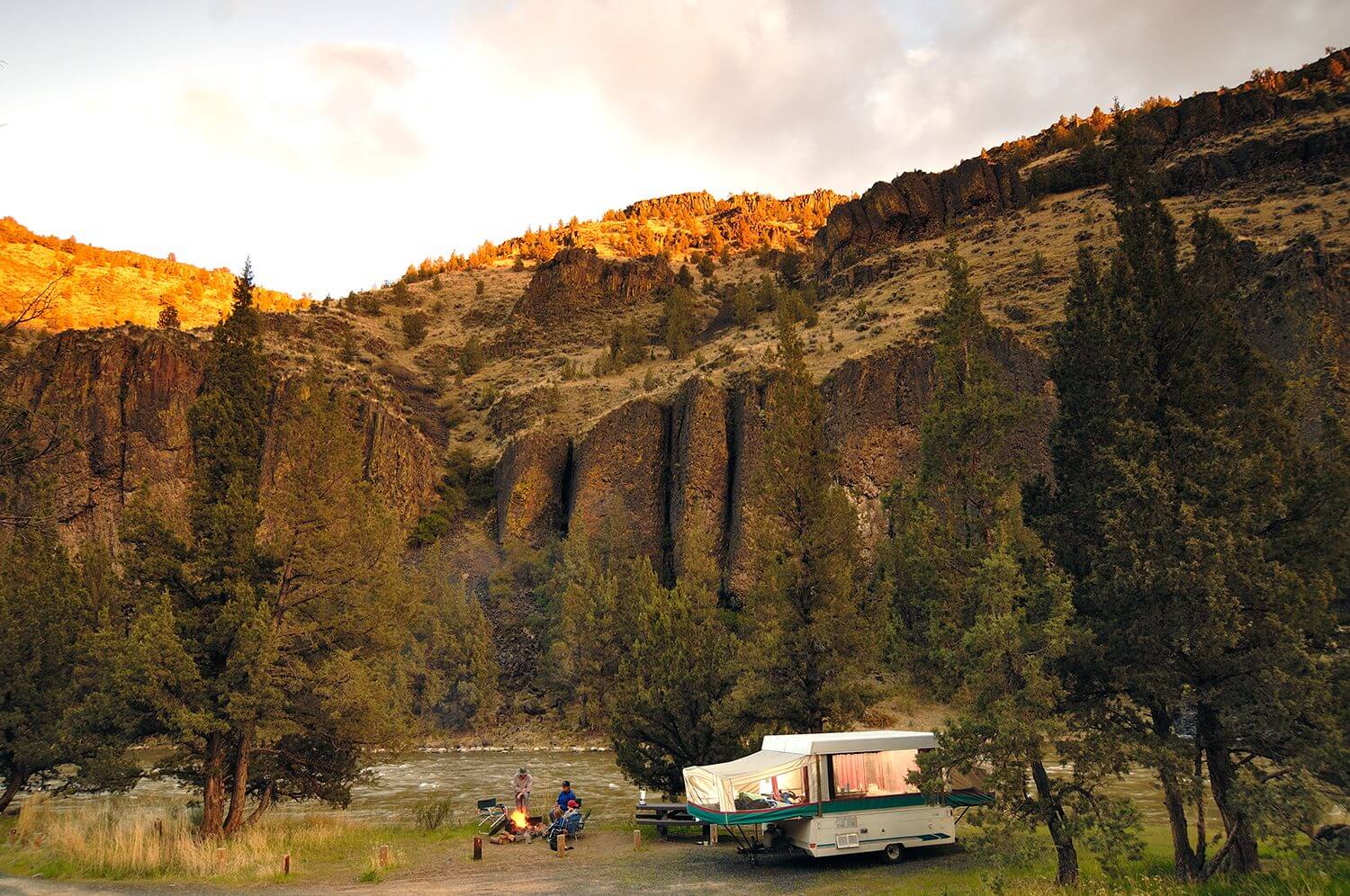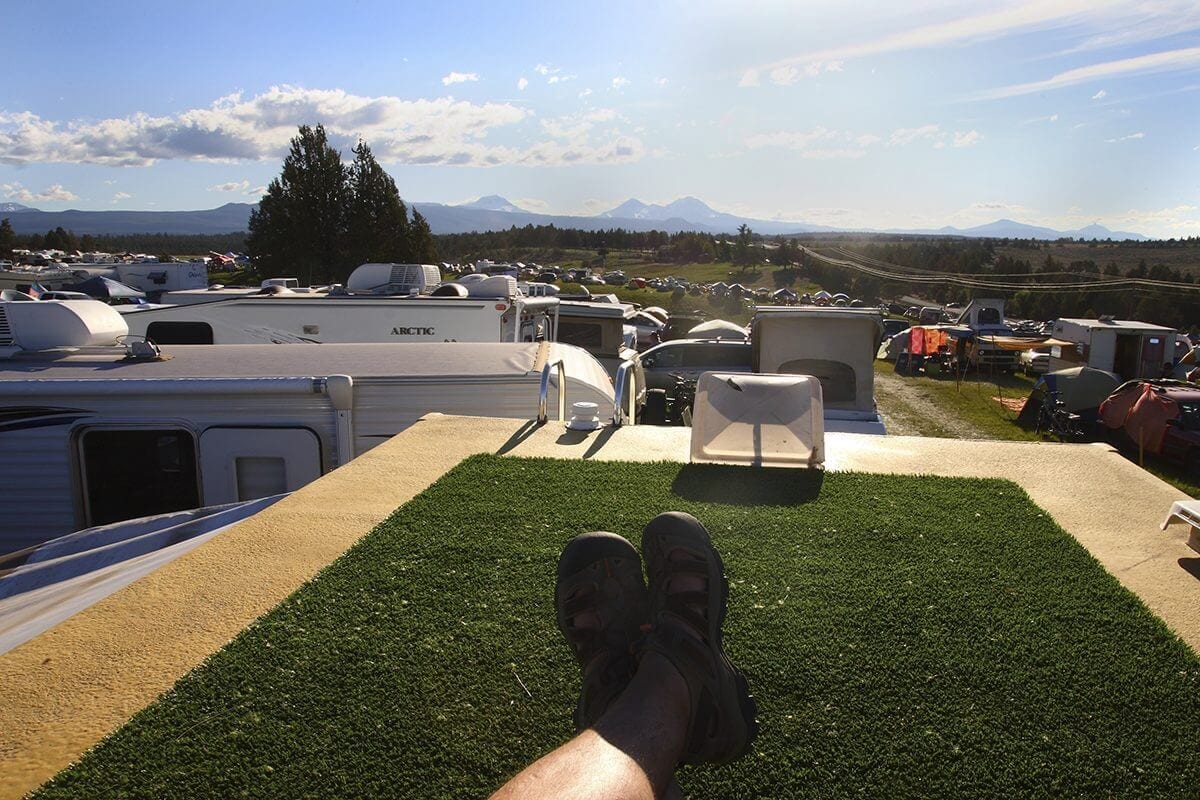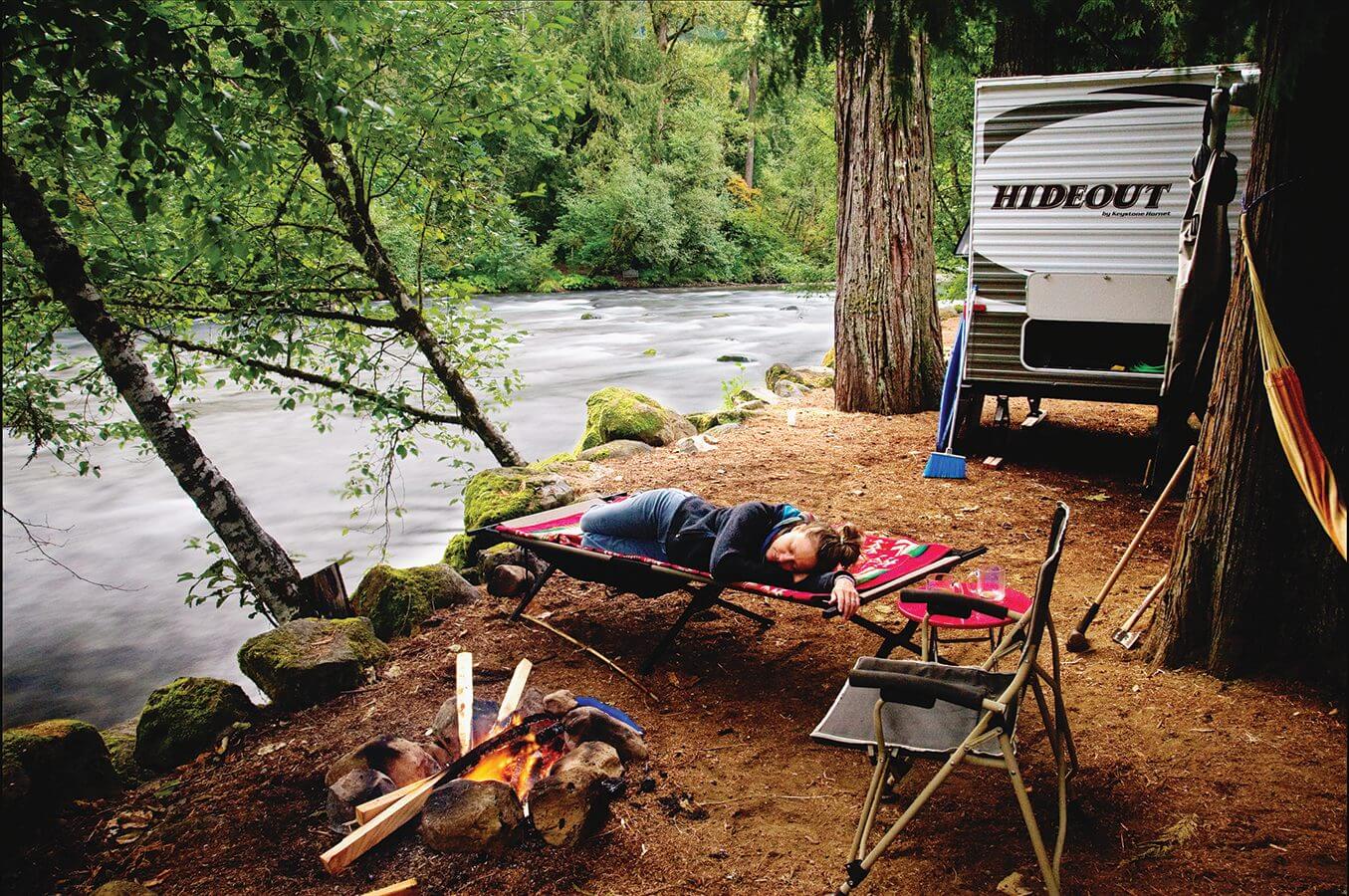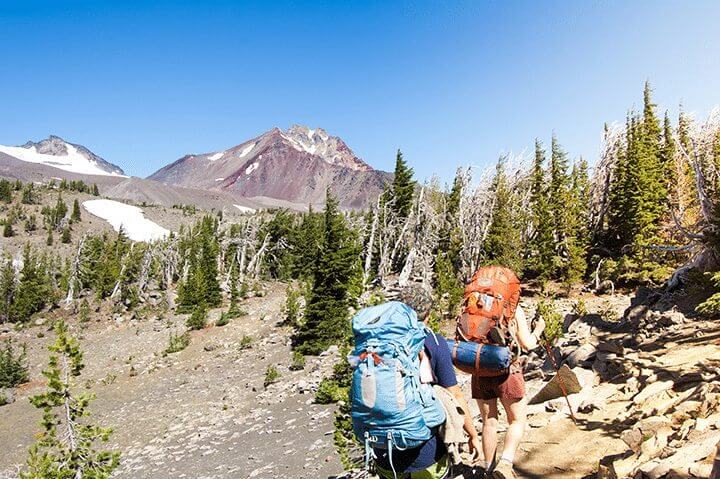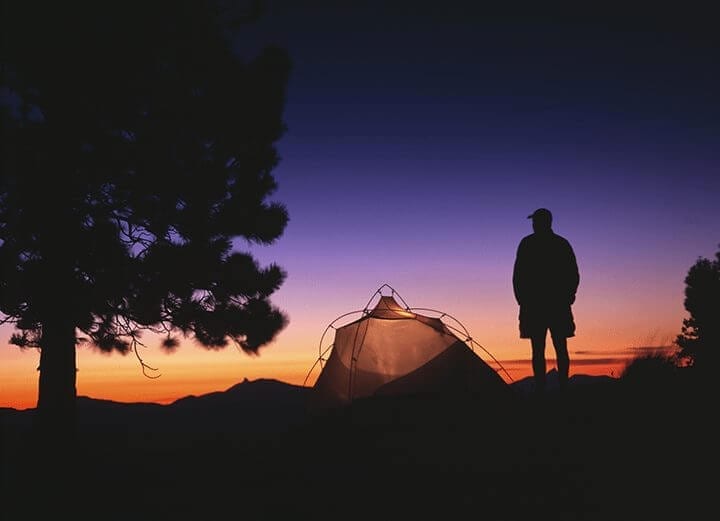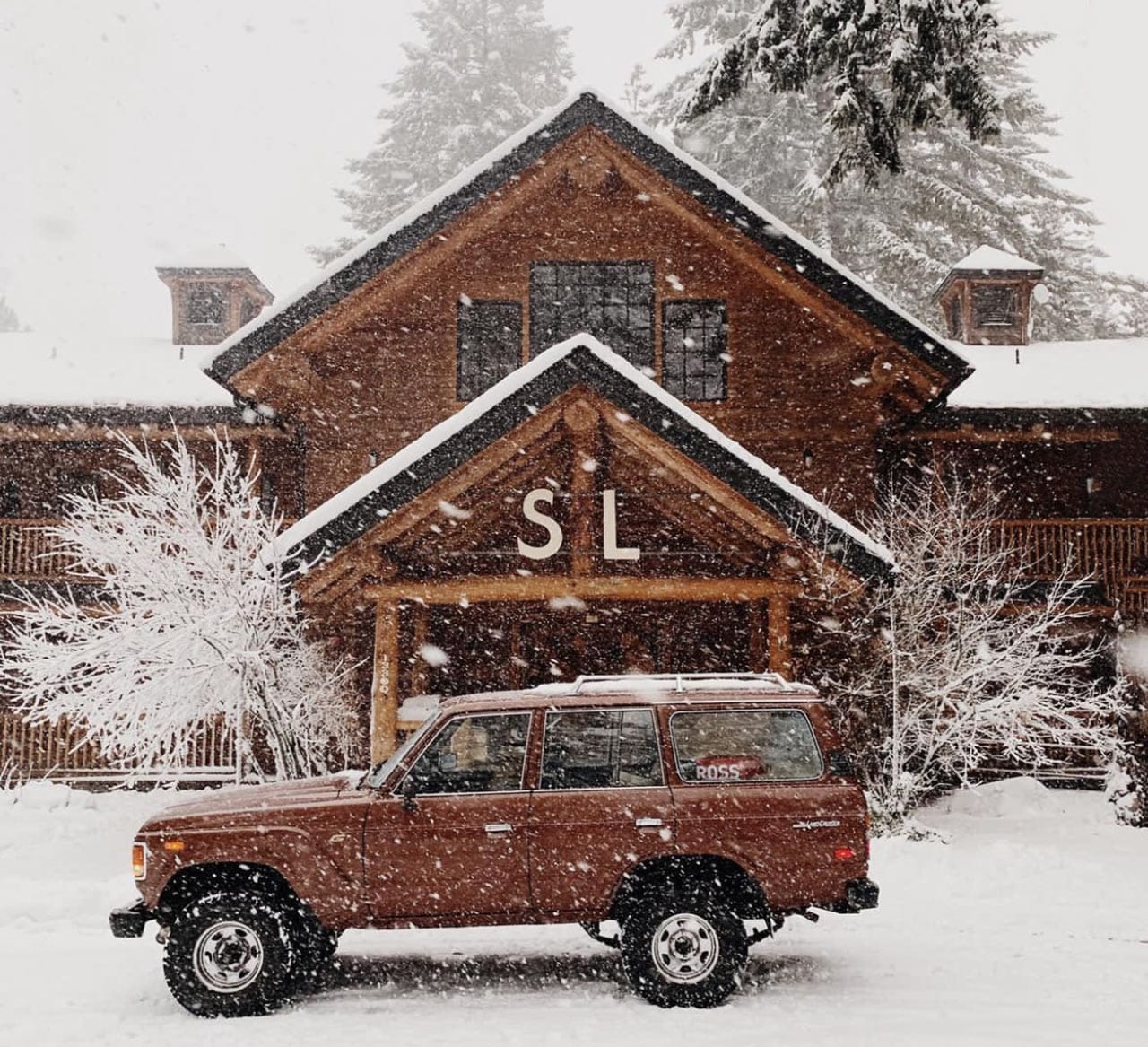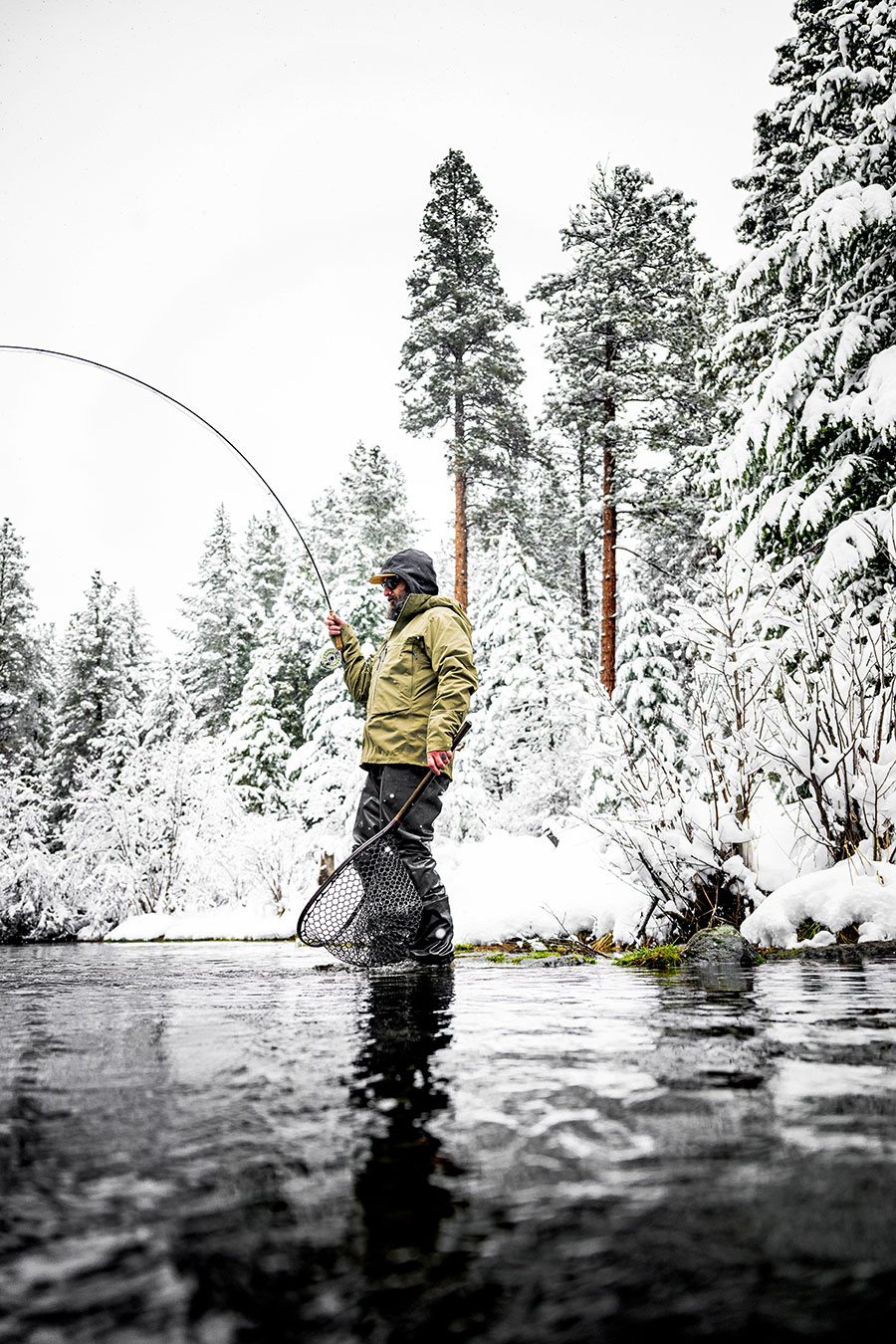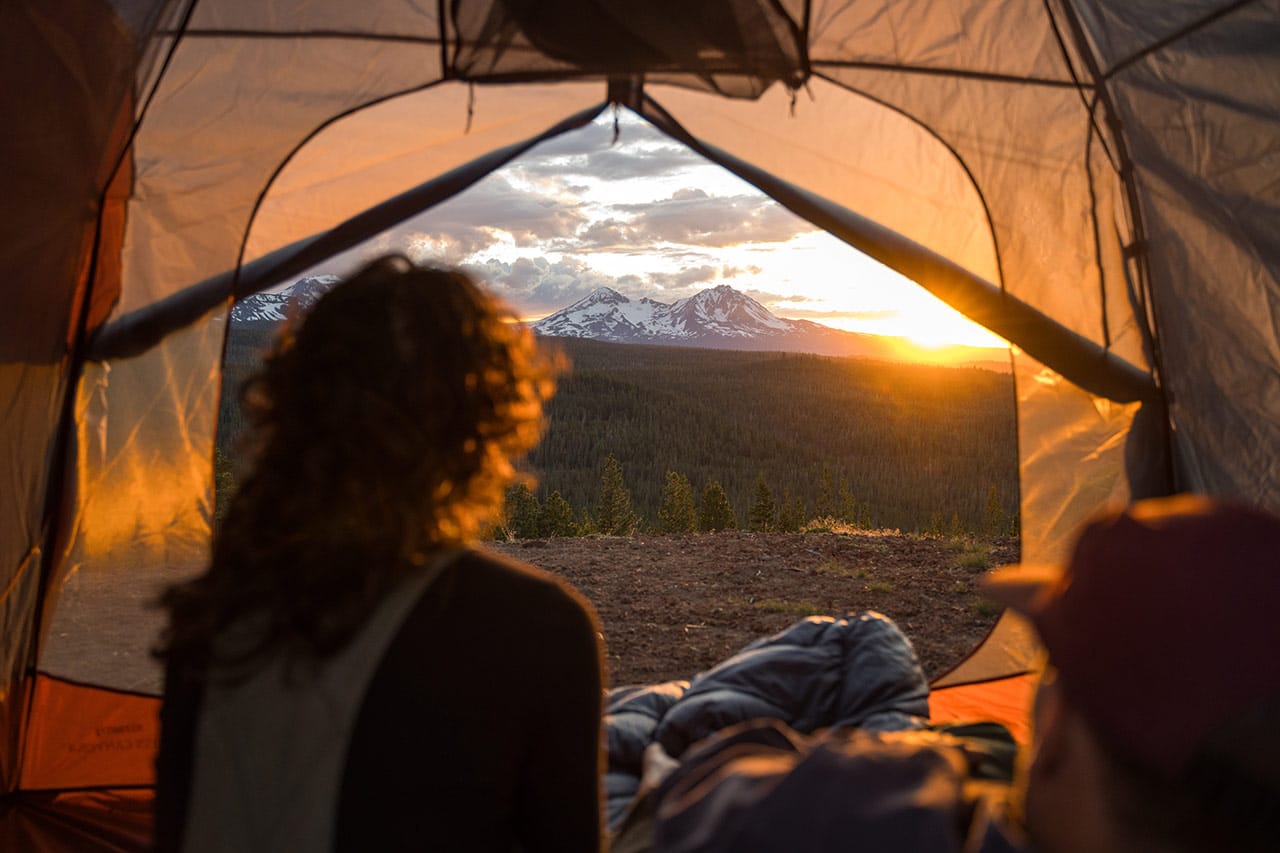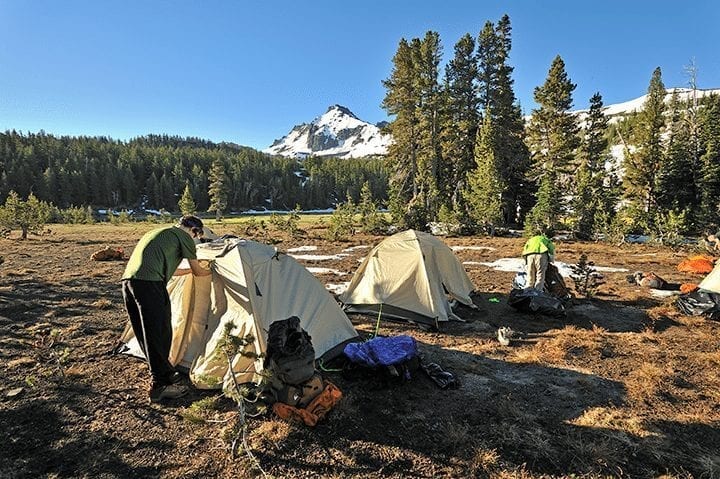
From walk-in wilderness to full hook-up RV camping, Central Oregon has a multitude of camping destinations. Here are six must-see sites that suit every style.
written by Eric Flowers
GRAB THE KIDS
Car Camping
Car Camping. It’s still a dirty word in some circles, usually predicated with some dubious claims of laziness. (Hint: there are no lazy people in Bend. And if there are, they aren’t out camping.) Kids are also a convenient excuse. As in, “We used to backpack the (insert amazing, secluded wilderness area), but with the kids…”
The dirty little secret is that car camping is as American as the fastball and cherry pie. So let’s stop making excuses as to why we loaded up the Subaru to overflow, brought two sets of everything and threw in the reclining chairs for good measure. Camping in style doesn’t go out of style.
That isn’t to say there isn’t a time and place for a multiday backpacking trip subsisting on dehydrated food and filtered water, but let’s give car camping its due. With that said, you could probably exhaust back issues of any camping-centric magazine looking for the perfect destination and not find a better basecamp than Bend. Local geography finds us perched on the edge of a mountain range and a desert that stretches to the Great Basin. It’s not an exaggeration to say that you could stand atop Pilot Butte, survey the horizon and find a worthy destination in every direction. With so many options, here are a few recommendations to either add to your bucket list or keep in your regular rotation.
 Wild & Scenic Crooked River
Wild & Scenic Crooked River
Just a short forty-five-minute drive from most parts of Bend, it’s easy to forget just what an amazing resource Central Oregon has in the Crooked River. One of two major tributaries to the Deschutes, including the Metolius, the Crooked River springs to life high in the Ochoco Mountains before turning northwest toward its intersection with the Deschutes at Crooked River Ranch. Before it gets there, it passes through a roughly fifteen-mile stretch below Prineville Reservoir that was designated as a Wild and Scenic waterway by Congress in 1988. Here the river twists through a rugged basalt canyon with soaring rimrock walls. The river dances along in riffles and pools beside the Crooked River highway, offering amazing access to this resource. Beginning at Big Bend, just below Bowman Dam, campgrounds sprout along the highway—tucked in groves of mature Ponderosa and juniper. Thanks to good fishing and great access, spots can be hard to come by in peak season, but those who arrive early are rewarded with a stunningly scenic backdrop for a weekend camping excursion.
“It’s nice when you live in the city to get away from the stress and everything,” said Melissa Byrne, who staked out a perfect spot below the iconic Chimney Rock on an early May weekend.
Byrne, 53, who works as a service contract manager, said she and her partner weren’t headed anywhere in particular when they packed up their station wagon and loaded in their dog, George, an amiable Dachshund mix.
“We try not to go to the same place twice,” she said. “We kind of go where we end up.”
East and Paulina Lakes
While sometimes overlooked by locals, this popular destination draws visitors from around the Northwest and beyond—and for good reason. It’s not every campground that’s nested in the belly of a dormant shield volcano, though you wouldn’t really guess Newberry’s cataclysmic history based on the serenity found there today. Thanks to restrictions on motorized recreation, the entire inner rim of the volcano is designated as a National Monument. It’s easy to slip away from the sounds of the campground and escape for a quiet sunset. A year-round destination for some, thanks to extensive snowmobile and backcountry skiing opportunities, Newberry really comes alive in late spring when the road is finally cleared after a winter of accumulated snow. This opens up scores of small and large campsites that ring the two lakes located in the bowels of the volcano, a product of eons of snow and rain melt. In addition to world-class fishing (Paulina Lake yielded the state record brown trout), there are miles of shore hiking trails, as well as a popular trail around the entire crater rim that is a must for experienced mountain bikers. There are also DIY hot springs around the area that make for great soaking pools when dug out with a shovel. A pair of resorts (one on East Lake and one on Paulina) means you’re in luck for last-minute supplies.
(NOT) ROUGHING IT
Trailers & RV
 Combine the fickle weather of the Northwest with the predictable unpredictability of mountain climates and you have a recipe for snow in July and frost on the ground before October. This can make for, well, challenging conditions to enjoy the great outdoors. Add in a few kids and overworked parents, and you’ve got a recipe for a camping disaster. It’s probably no wonder that so many families have embraced a refined approach with the addition of travel trailers and, in some cases, motorhomes. But let’s get this out of the way: No one wants to saddle up next to a rig with a generator running outside their tent door or wake up with a forty-foot coach parked in what was previously a view of the evening sunset. That being so, there’s a time and place for trailers and motorhomes. Those who thumb their noses should try sleeping in a tent with a crying infant or spending a weekend huddled against an October winter storm with only a vinyl wall for insulation. Trust us. There’s a better way.
Combine the fickle weather of the Northwest with the predictable unpredictability of mountain climates and you have a recipe for snow in July and frost on the ground before October. This can make for, well, challenging conditions to enjoy the great outdoors. Add in a few kids and overworked parents, and you’ve got a recipe for a camping disaster. It’s probably no wonder that so many families have embraced a refined approach with the addition of travel trailers and, in some cases, motorhomes. But let’s get this out of the way: No one wants to saddle up next to a rig with a generator running outside their tent door or wake up with a forty-foot coach parked in what was previously a view of the evening sunset. That being so, there’s a time and place for trailers and motorhomes. Those who thumb their noses should try sleeping in a tent with a crying infant or spending a weekend huddled against an October winter storm with only a vinyl wall for insulation. Trust us. There’s a better way.
Dave Naftalin was so smitten with camping and the outdoors as a kid growing up on the East Coast that he worked for a time as a park ranger as an adult. Like many children of the ’90s his interests tended toward backcountry camping and the exploration of remote places. But like others of his generation he got married, had kids and discovered that unlike his favorite mug, the kids didn’t fit neatly in a backpack. There were other reasons, too, that led Naftalin and a friend to decide five years ago to split the cost of a second-hand motorhome. It was the convenience that finally led them to make the leap.
“The two factors were kids number one and wanting to go to Bachelor and camp every weekend of the winter if we wanted to with the kids,” said Naftalin.
They also found that it came in handy at music festivals where a personal bathroom is a great alternative to porta potties and the attendant conditions.
While he readily admits that he and his wife don’t fit the motorhome stereotype, it’s a contradiction that they relish. These days he loves pulling up to a cavalcade of silver-haired motorhomers and watching the reaction as his kids burst forth like soda from a shaken bottle.
Depending on the weekend, the motorhome can be headed to mountain, coast or desert. Sometimes all three. There’s always one common denominator, said Naftalin: “The family is in its most harmonious state in the camper.”
Cove Palisades State Park
If you’d rather have the convenience of full-electric hook-ups, access to shower facilities and other amenities but don’t want to sacrifice the sunsets, look north to the Cove Palisades State Park where more than 150 full RV slots are split between two campgrounds. You won’t be lacking for creature comforts but there are also opportunities for hiking and bird watching, including the annual Eagle Watch event in February that draws hundreds of birders and raptors alike. There is also ample access to Lake Billy Chinook, the expansive reservoir that lies behind the Pelton Round-Butte Dam complex at the confluence of the Deschutes, Metolius and Crooked rivers. Whether it’s fishing, pleasure boating or wakeboarding and tubing, there are plenty of ways to whittle the day away on the water. Boat rentals are offered at the marina on an hourly and daily basis.
Walton Lake
While most National Forest campgrounds are suited to accommodate RV’s and travel trailers, some are better equipped to accommodate larger vehicles. Walton Lake is one of those destinations. Several years ago the campground received a makeover to make it more accommodating for these visitors. Today the cozy campground in the Ochocos has twenty-one sites set up for RV’s and trailers. The campground offers easy access to its namesake waterbody, a small lake that is stocked with trout and includes a beach for summertime frolicking. There are also nearby hiking trails, including a loop at Walton Lake and the multi-use Round Mountain Trail.
PACK IT IN
Backcountry
 We may not have the peaks of Yosemite or the grizzlies of Glacier, but Central Oregon is a perfect launching point for countless backcountry camping adventures. From subalpine lakes ringing the Three Sisters to the novelty of paddle-in camping at Sparks Lake, there is a backcountry itinerary for anyone who has a passion for exploration. Here is a short list of overnight backcountry trips that offer a taste of what the region offers.
We may not have the peaks of Yosemite or the grizzlies of Glacier, but Central Oregon is a perfect launching point for countless backcountry camping adventures. From subalpine lakes ringing the Three Sisters to the novelty of paddle-in camping at Sparks Lake, there is a backcountry itinerary for anyone who has a passion for exploration. Here is a short list of overnight backcountry trips that offer a taste of what the region offers.
Mt. Jefferson Wilderness
Just beyond the faux-Western storefronts of Sisters lie more than 100,000 acres of federally designated wilderness with the majestic Mt. Jefferson at its heart. More than 100 alpine lakes, many of them stocked with trout, dot the landscape. Almost 200 miles of trails offer untold opportunities for exploration. Depending on the time of year, don’t be surprised if you encounter hikers passing through on an epic quest to complete the 1,000-mile Pacific Crest Trail. Some forty miles of it wind through the Mt. Jefferson Wilderness. In terms of breathtaking terrain and diversity, it’s hard to beat the area. However, it’s also heavily trafficked. So much so that the Forest Service has moved to a limited entry permit system at many of the most popular areas, including Jefferson Park and the Pamelia Lake areas.
“Because Mt. Jefferson is located between major populations in the valley and Bend, Redmond and Sisters, it is very highly used. You will see a lot of people. If solitude is what you’re looking for, it’s probably not the place to go,” said Brad Peterson, wilderness manager for the Willamette National Forest. “That being said, it does have some amazingly unique characteristics that you won’t see a lot of in other places.”
Two such characteristics include the park’s eponymous peak, the second highest in the state of Oregon, and areas that are recovering from recent wildfires and offer a glimpse into how healthy ecosystems rejuvenate.
Three Sisters Wilderness & Cascade Lakes
Myriad options greet explorers of this expansive wilderness area just minutes from Bend. This is also the place where many families choose to embark on their first tentative steps into the backcountry with younger children. (It’s easier to be ambitious when your safety is a home or hotel less than an hour away.) Chad Lowe and wife Sarah Durfee made their first foray about four years ago, on an overnight trip to Todd Lake with son Ethan, then 5 and daughter Zoe, then 3.
“They carried in their stuffed animals,” recalled Lowe, an assistant principal at Redmond High School.
Since then it’s become an annual outing, usually involving other families.
“We try to pick a new spot every year and we go with two other families. They have kids around the same age. So our range expands a little every year (as the kids grow older),” said Lowe.
While the Cascade Lakes Highway opens beyond Mt. Bachelor around Memorial Day, it can be weeks before some of the area’s high country is accessible. Once the snow recedes, it opens hundreds of miles of trails and backcountry exploration options. Hikes through dense stands of hemlock and Doug fir lead to hidden waterfalls and shimmering alpine lakes tucked in the shoulders of the surrounding hillsides. Similar to Jefferson, this is a highly-trafficked area and is particularly vulnerable to human impacts. Respect the leave no trace ethos and familiarize yourself with all local regulations, including fire regulations and camping restrictions.



